|
The Monty's First Four
Locks -
Published in
Pipeline in spring 2008
If all goes well, this should
be the first of a series of articles about what is now called the
Montgomery Canal, but what we know affectionately as ‘The Monty’. Of
course, there was a time when neither name was correct; this section of
waterway having been opened in 1796 as a branch of the Ellesmere
Canal—another name lost to subsequent mergers and sell-offs.
|
The Monty housed a
vibrant business community, carrying cargoes of limestone, wood, bones, wool
and numerous other less voluminous cargoes. With the lack of a railway
system extending from the border counties into Wales, the Monty also became
a busy lifeline for human cargoes, sharing the infamous fly boats with the
more precious cargoes en route to Newtown. In its entirety, the Monty
stretched from Frankton Locks, passing through Welshpool and terminating at
Newtown, some 35 miles in length. It is an ‘international canal’, in that it
commences in England, then crosses the border into Wales at Llanymynech,
where an isolated short stretch is currently navigable, but disconnected
from other navigable sections, both northwards and southwards of it. |
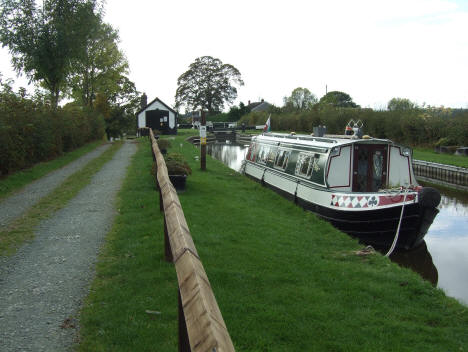
The approach to Frankton lock at
Frankton junction |
I’ll be concentrating on the northern
seven to eight miles of navigable waterway which is connected to the main system
at Frankton Locks, on the Llangollen Canal. At the time of writing, the extent
of navigation takes us to Gronwen Wharf, at bridge 82, shown in the photo below.
However, as I type, the next section of canal, seen through the bridge hole, is
being watered in preparation for its reopening in mid October.
|
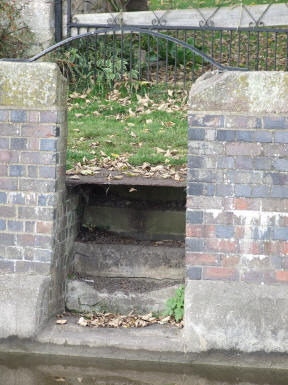
The Canal Tavern steps now
capped over |
So, let’s return to
Frankton and take a look at what we find as we work our way through the
Monty’s first 4 locks, dropping us out of the Llangollen Canal.
Undoubtedly, the
first feature to catch any boater’s eye will be the attractive setting. The
lock-keeper’s hut at lock 1 and all of the structures around about are cared
for by the resident lock keeper, Colin Payne, who regularly takes awards for
his efforts and who has befriended many a boater, both seasoned and novice,
with his flowing banter about life on the Monty. He’s quite an ambassador
for BW and the English Tourist Board alike! Get him talking about antiques,
BW management strategies or what can go wrong on the waterways and you can
be assured of a lengthy, passionate conversation. If you’re in a hurry,
stick to less contentious topics! |
At Frankton we have four locks; a
staircase pair and two singles, with short pounds in between. What makes this
system of four locks rather unusual is the presence of canal-side enterprises of
old, within the pounds between the bottom two locks. Given that boats would be
tied up for hours, or even days at a time, it’s all the more unusual to find a
boat yard and an tavern at such a location.
|
Alongside the pound between the staircase pair and lock 3, lies a farm
building that once currently operated as the Canal Tavern. Until recently
this property was home to the Hyde family, who operated their own boat
service as a part of their farming and transport business. Given the ability
of certain boatmen of old to consume alcohol, the tavern had a high wall
built between itself and the lock pound, with a stone stairway to get its
patrons back down to their boats. Plenty remains to remind us of this,
including the iron tow-rope guide set into the top stones of the wall,
presumably to prevent tow ropes fouling. The steps (now covered) project
back across the towpath and seem to have been as much a hindrance as they
were meant to be of help! There are records of several boatmen falling in at
this point, in deed, Sam Owen, of the Newtown flyboat Trentham died when he
fell in and drowned in the small hours. |
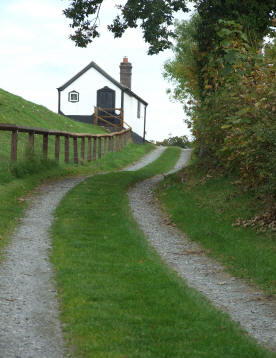
The lane up to the lock-keeper's hut
at Frankton from below the staircase pair. |
Between locks three and four, and
extending the whole length of the short pound, is a splendid cottage, frequently
admired for its garden. Look closely though, and you will see remnants of
stonework in the garden that suggest the presence of derelict structures allied
to the canal industry. When the current occupier bought this house it was in a
state of dereliction. I stopped and had a chat with them in October and some of
what follows is an account of the story they related.
A recluse, who sadly suffered from
schizophrenia and passionately distrusted strangers, occupied the cottage. The
cottage had no electricity, water, drainage or other amenity. All its windows
were broken, as the recluse had taken to throwing stones at passers-by.
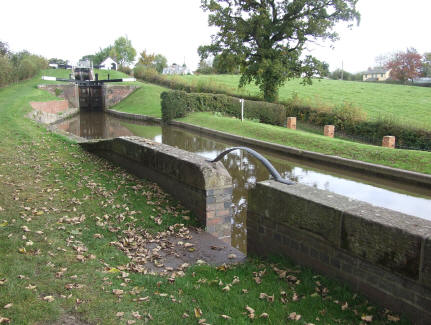
The towing rope guide over the Canal Tavern steps. |
When, in 1979, WRG
volunteers turned up in force to restore the locks, the recluse fled into
the local fields, where he presumably lived for the duration of the
restoration works, whilst the volunteer force occupied the cottage,
believing it to be vacated. However, as time progressed, the current owner
bought the property and set about restoring it. In the garden they found
evidence of a former dry-dock. Research showed that the whole cottage and
its grounds were once a boatyard, which continued to trade up to 1941, in
the hands of John Beech, who had served as an apprentice to the trade at
Norbury Junction. |
Little could the current owners of the
cottage have realised that their garden had been host to one of our waterway’s
most famous boats, Cressy, the fly boat bought by Tom Rolt for his cruises
around the canal system that led to his writing the book ‘Narrow Boat’. Cressy
had been converted at the boatyard to a pleasure boat, complete with her new
steam engine.
|
Unfortunately, when the lock pound was
restored, for whatever reason, the dry dock didn’t feature in any of the
restoration works, and the new coping stones and bricks were laid straight
across the entrance to it. No doubt, had the restoration work been undertaken in
more recent years, the dock would have been afforded rather more attention and
who knows, it even still be in service. Nonetheless, the owners are mindful of
their role as protectors of this piece of history, and have uncovered what
remains on site. |
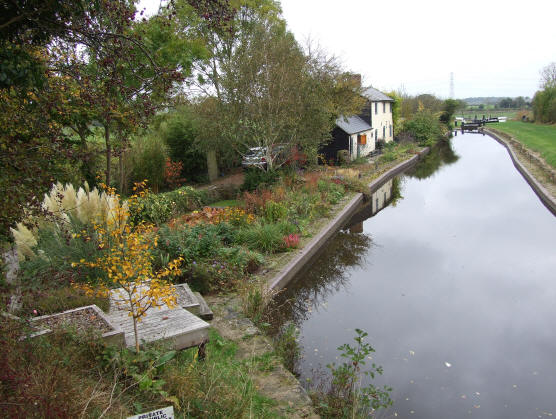
Frankton dry dock
|
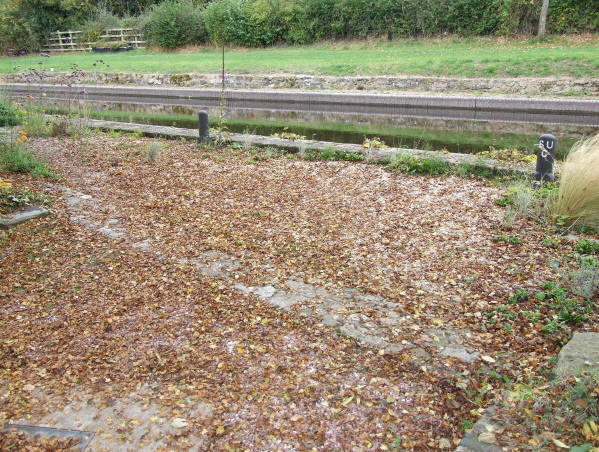
Frankton dry dock
|
I was fortunate enough to be allowed access to the dry-dock, where I was
shown the original stop planks, which had been restored and returned to the
entrance to the dock. I was also able to see that the shoring stones are
still visible inside the lock, as is the line of the original wharf-edge
coping-stones and a few of the iron mooring bollards.
|
|
The owners have
attempted to reinstate what they believed was a sluice, issuing from the
side of the dock and simply spilling into an adjacent stream, but they have
since discovered that no such feature formerly existed; emptying of the dock
was facilitated by natural leakage through the dock walls into the stream! |
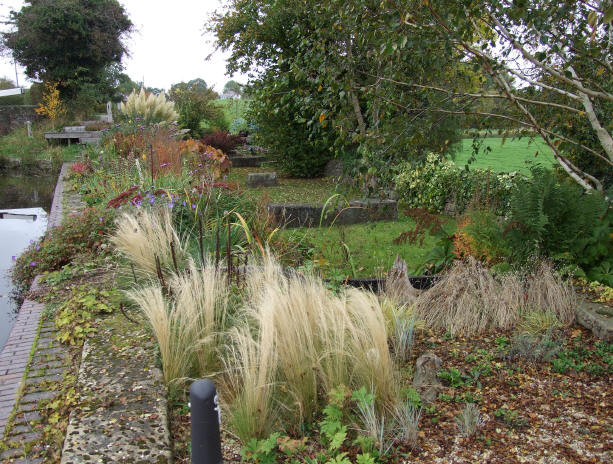
Frankton dry dock showing stone shorings and stop
planks in foreground |
by Les Symonds. Published in Pipeline in
spring 2008
Return
to Pipeline Index |



